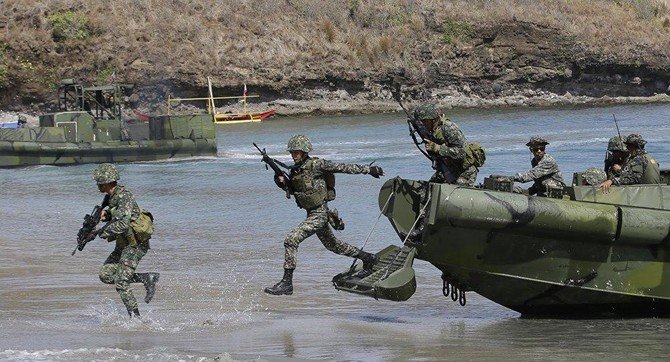SEA: The once feared Abu Sayyaf Group no longer reigns the seas
Philippine Marines exit a U.S. landing craft as they assault a target during joint military exercises dubbed Balikatan. About 8,000 combined US and Philippine troops will take part in Balikatan 2018, along with a small contingent from the Australian and Japanese armed forces. (Source: AP Photo)
3 March 2022
While there is no question that Abu Sayyaf Group operatives have the capability to kidnap crew from cargo vessels, the intensified and sustained pressure from Malaysian and Philippines forces has prevented kidnapping operations that target cargo vessels since 2018. In this briefing, south-east Asia analyst Thomas Timlen provides background.
By Thomas Timlen, south-east Asia analyst
On 18 March 2021 the last four seafarer hostages held by the Abu Sayyaf Group (ASG) were freed by the Philippines Armed Forces. Kidnapped from their fishing trawler SSK 00543 in the Sulu Sea about four nautical miles off the coast of Sabah with four of their colleagues on 17 March 2020, they had spent a full year held by ASG militants in encampments throughout the Sulu Archipelago. Three of their shipmates had been freed earlier on 18 January 2021, while one died during a rescue operation on 29 September 2020.
The rescue of the crew kidnapped from the SSK 00543 coincided with a series of misfortunes for the ASG. The rescue took place during an attempt by several ASG leaders and members to flee to Sabah, moving along the Sulu archipelago on motorboats from strongholds on Jolo and Basilan in the east towards Tawi Tawi in the west. ASG operatives who succeeded in fleeing to Sabah did not, however, manage to elude the long arm of the law. Malaysian authorities tracked them down in the jungle of Sabah, where several ASG militants were arrested while others were killed.
Meanwhile, intensified operations in the Philippines have continued with additional ASG militants and leaders being arrested or killed, while many more lay down their weapons to surrender, accepting government programs that provide amnesty and reintegration. Since March 2020 ASG operations to acquire new hostages at sea have failed, instead resulting only with the deaths of ASG militants caught in the gunsights of the Philippines Armed Forces. Unable to operate on the waters of the Sulu and Celebes Seas, the remaining ASG personnel have resorted to the recruitment of suicide bombers who have been used to target markets, places of worship and government facilities.
Risk Intelligence tallied a total of 85 seafarers that were kidnapped from 21 vessels between 2016 and 2020. Prior to this period the ASG had targeted tourists and yachtsmen. Of the 85 seafarers taken hostage, 39, representing 46% of the total, were taken from fishing trawlers. Of the remaining 46; 32 crew were taken from 6 tugs, 2 from a heavy lift vessel, 6 from a bulk carrier, and 6 from a general cargo ship. After the kidnapping of 6 crew from the general cargo ship GIANG HAI 5 on 19 February 2017, all subsequent successful ASG-related kidnap for ransom operations were limited to crew on fishing trawler.
The last attempt by the ASG to kidnap crew from a cargo ship took place on 16 February 2018, when the KUDOS 1 was attacked in the waters of the Moro Gulf off Sibago Island, while a tug experienced a failed attack on 05 December 2018 off Sabah. In both cases the crew were able to defend their vessels by effectively implementing evasive manoeuvres.
There is no question that ASG operatives have the capability to kidnap crew from cargo vessels, however, the intensified and sustained pressure from Malaysian and Philippines forces has prevented kidnapping operations that target cargo vessels since 2018. During subsequent years, the ASG has only been capable of attacking fishing trawlers, but with shrinking ranks this activity also ceased to be effective since January 2020.
At the peak of this activity during 2016 and 2017, aside from fishing trawlers and tugs, the ASG only targeted two general cargo vessels, one bulk carrier and one heavy lift vessel. In view of the sustained pressure that the ASG faces from Malaysian and Philippine forces, the likelihood of a resurgence of kidnapping of crew serving on internationally-trading vessels that keep within the recommended transit corridors is seen as low, although fishing trawlers and tugs will remain vulnerable.
Nonetheless, the waters along the Sulu archipelago are likely retain their reputation as a kidnap for ransom zone. Whilst the threat of encountering such attacks has declined, it remains advisable to utilise the designated transit corridors, as regional navies continue to patrol these waters and can respond quickly if needed. Like a cornered wild animal, remaining ASG militants could still take desperate measures as forces beyond their control continue to close in.
LEARN MORE:
Users of the Risk Intelligence System can obtain regularly updated assessments of the threats posed by the ASG from the Threat Assessments for the Philippines and the Sulu/Celebes Seas. Subscribers to the Risk Intelligence Monthly Reports can also find related information in the Southeast Asia section.

